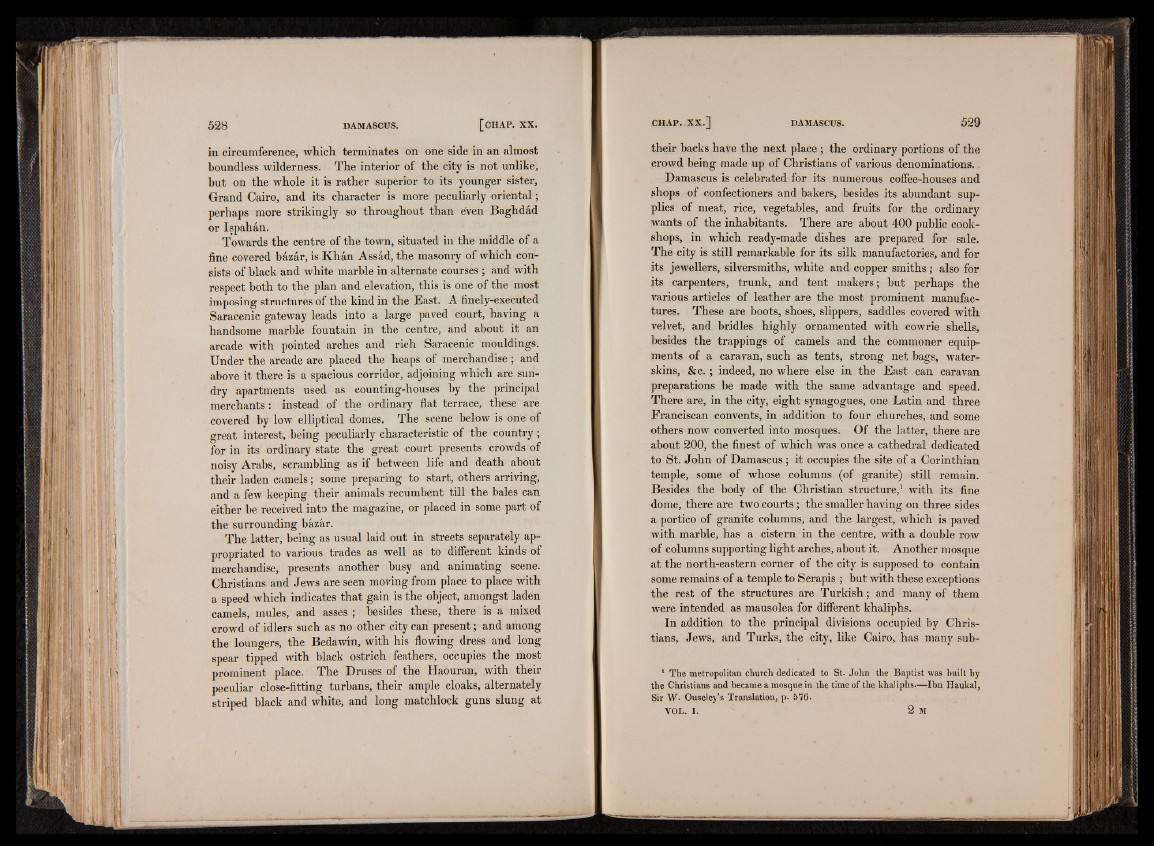
in circumference, which terminates on one side in an almost
boundless wilderness. The interior of the city is not unlike,
but on the whole it is rather superior to its younger sister,
Grand Cairo, and its character is more peculiarly oriental;
perhaps more strikingly so throughout than even Baghdad
or Ispahan.
Towards the centre of the town, situated in the middle of a
fine covered bazar, is Khan Assad, the masonry of which consists
of black and white marble in alternate courses ; and with
respect both to the plan and elevation, this is one of the most
imposing structures of the kind in the East. A finely-executed
Saracenic gateway leads into a large paved court, having a
handsome marble fountain in the centre, and about it an
arcade with pointed arches and rich Saracenic mouldings.
Under the arcade are placed the heaps of merchandise; and
above it there is a spacious corridor, adjoining which are sundry
apartments used as counting-houses by the principal
merchants: instead of the ordinary flat terrace, these are
covered by low elliptical domes. The scene below is one of
great interest, being peculiarly characteristic of the country ;
for in its ordinary state the great court presents crowds of
noisy Arabs, scrambling as if between life and death about
their laden camels; some preparing to start, others arriving,
and a few keeping their animals recumbent till the bales can
either be received into the magazine, or placed in some part of
the surrounding bazar.
The latter, being as usual laid out in streets separately appropriated
to various trades as well as to different kinds of
merchandise, presents another busy and animating scene.
Christians and Jews are seen moving from place to place with
a speed which indicates that gain is the object, amongst laden
camels, mules, and asses ; besides these, there is a mixed
crowd of idlers such as no other city can present; and among
the loungers, the Bedawin, with his flowing dress and long
spear tipped with black ostrich feathers, occupies the most
prominent place. The Druses of the Haouran, with their
peculiar close-fitting turbans, their ample cloaks, alternately
striped black and white, and long matchlock guns slung at
their backs have the next place ; the ordinary portions of the
crowd being made up of Christians of various denominations. -
Damascus is celebrated for its numerous coffee-houses and
shops of confectioners and bakers, besides its abundant supplies
of meat, rice, vegetables, and fruits for the ordinary
wants of the inhabitants. There are about 400 public cook-
shops, in which ready-made dishes are prepared for sale.
The city is still remarkable for its silk manufactories, and for
its jewellers, silversmiths, white and copper smiths ; also for
its carpenters, trunk, and tent makers; but perhaps the
various articles of leather are the most prominent manufactures.
These are boots, shoes, slippers, saddles covered with
velvet, and bridles highly ornamented with cowrie shells,
besides the trappings of camels and the commoner equipments
of a caravan, such as tents, strong net bags, waterskins,
&c. ; indeed, no where else in the East can caravan
preparations be made with the same advantage and speed.
There are, in the city, eight synagogues, one Latin and three
Franciscan convents, in addition to four churches, and some
others now converted into mosques. Of the latter, there are
about 200, the finest of which was once a cathedral dedicated
to St. John of Damascus; it occupies the site of a Corinthian
temple, some of whose columns (of granite) still remain.
Besides the body of the Christian structure,1 with its fine
dome, there are two courts; the smaller having on three sides
a portico of granite columns, and the largest, which is paved
with marble, has a cistern in the centre, with a double row
of columns supporting light arches, about it. Another mosque
at the north-eastern corner of the city is supposed to contain
some remains of a temple to Serapis ; but with these exceptions
the rest of the structures are Turkish; and many of them
were intended as mausolea for different khaliphs.
In addition to the principal divisions occupied by Christians,
Jews, and Turks, the city, like Cairo, has many sub-
1 The metropolitan church dedicated to St. John the Baptist was built by
the Christians and became a mosque in the time of the khaliphs— Ibn Haukal,
Sir W. Ouseley’s Translation, p. 576.
VOL. I. 2 M